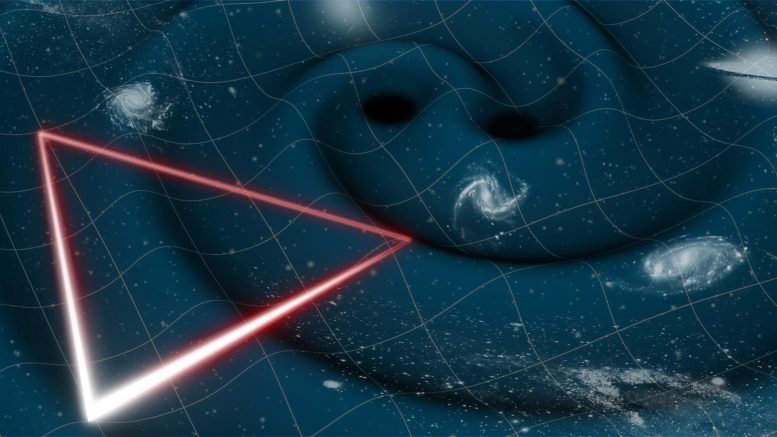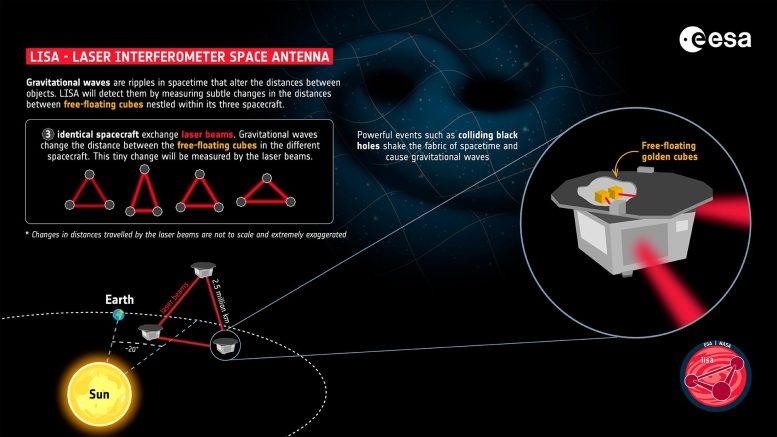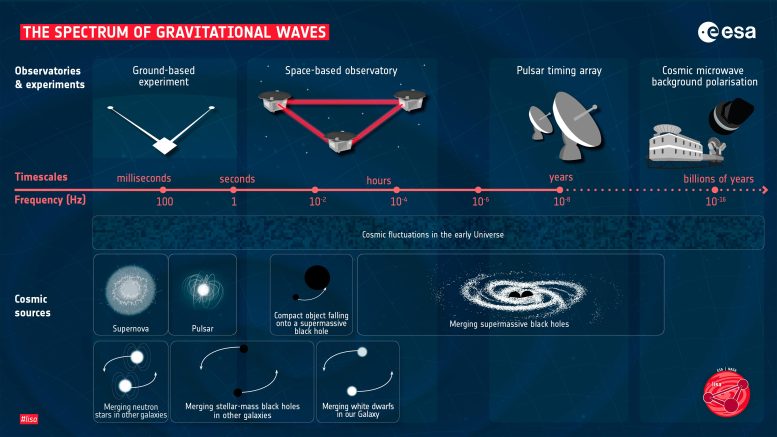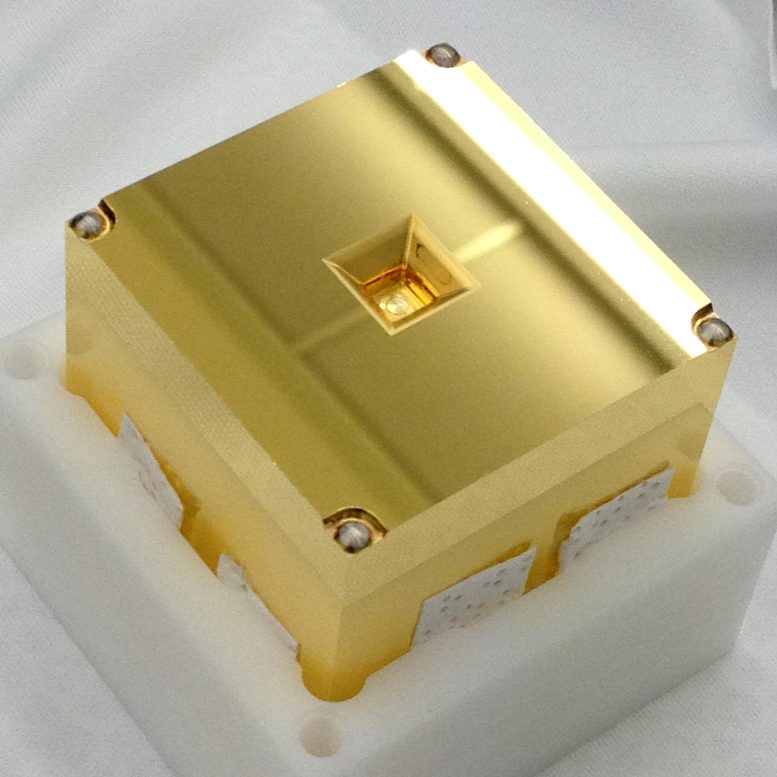
ESA’s approval of the LISA mission marks a significant advancement in space science, aiming to detect gravitational waves with a trio of spacecraft. Launching in 2035, it will offer new insights into cosmic events and the universe’s expansion.
ESA’s Science Programme Committee has approved the Laser Interferometer Space Antenna (LISA) mission, the first scientific endeavor to detect and study gravitational waves from space.
This important step, formally called ‘adoption’, recognizes that the mission concept and technology are sufficiently advanced, and gives the go-ahead to build the instruments and spacecraft. This work will start in January 2025 once a European industrial contractor has been chosen.
LISA is not just one spacecraft but a constellation of three. They will trail Earth in its orbit around the Sun, forming an exquisitely accurate equilateral triangle in space. Each side of the triangle will be 2.5 million km long (more than six times the Earth-Moon distance), and the spacecraft will exchange laser beams over this distance. The launch of the three spacecraft is planned for 2035, on an Ariane 6 rocket.
Led by ESA, LISA is made possible by a collaboration between ESA, its Member State space agencies, NASA, and an international consortium of scientists (the LISA consortium).

Bringing ‘Sound’ to the Cosmic Movie
Just over a century ago, Einstein made the revolutionary prediction that when massive objects accelerate, they shake the fabric of spacetime, producing minuscule ripples known as gravitational waves. Thanks to modern technological developments, we are now able to detect these most elusive of signals.
“LISA is an endeavor that has never been tried before. Using laser beams over distances of several kilometers, ground-based instrumentation can detect gravitational waves coming from events involving star-sized objects – such as supernova explosions or merging of hyper-dense stars and stellar-mass black holes. To expand the frontier of gravitational studies we must go to space,” explains LISA lead project scientist Nora Lützgendorf.
“Thanks to the huge distance traveled by the laser signals on LISA, and the superb stability of its instrumentation, we will probe gravitational waves of lower frequencies than is possible on Earth, uncovering events of a different scale, all the way back to the dawn of time.”

LISA will detect, across the entire Universe, the ripples in spacetime caused when huge black holes at the centers of galaxies collide. This will enable scientists to trace the origin of these monstrous objects, to chart how they grow to be millions of times more massive than the Sun and to establish the role they play in the evolution of galaxies.
The mission is poised to capture the predicted gravitational ‘ringing’ from the initial moments of our Universe and offer a direct glimpse into the very first seconds after the Big Bang. Additionally, because gravitational waves carry information on the distance of the objects that emitted them, LISA will help researchers measure the change in the expansion of the Universe with a different type of yardstick from the techniques used by Euclid and other surveys, validating their results.
Closer to home, in our own galaxy, LISA will detect many merging pairs of compact objects like white dwarfs or neutron stars and give us a unique insight into the final stages of the evolution of these systems. By pinpointing their position and distances, LISA will further our grasp of the structure of the Milky Way, building upon the findings from ESA’s Gaia mission.
“For centuries we have been studying our cosmos through capturing light. Coupling this with the detection of gravitational waves is bringing a totally new dimension to our perception of the Universe,” remarks LISA project scientist Oliver Jennrich.
“If we imagine that, so far, with our astrophysics missions, we have been watching the cosmos like a silent movie, capturing the ripples of spacetime with LISA will be a real game-changer, like when sound was added to motion pictures.”

Golden Cubes and Laser Beams
To detect gravitational waves, LISA will use pairs of solid gold-platinum cubes – so-called test masses (slightly smaller than Rubik’s cubes), free-floating in special housing at the heart of each spacecraft. Gravitational waves will cause tiny changes in the distances between the masses in the different spacecraft, and the mission will track these variations using laser interferometry.
This technique requires shooting laser beams from one spacecraft to the other and then superimposing their signal to determine changes in the masses’ distances down to a few billionths of a millimeter.
The spacecraft must be designed to ensure that nothing, besides the geometry of spacetime itself, affects the movement of the masses, which are in freefall.
Solid Heritage and Future Teamwork
The spacecraft follows in the footsteps of LISA Pathfinder, which demonstrated that it is possible to keep the test masses in freefall to an astonishing level of precision. The same precision propulsion system that has also been flown on ESA’s Gaia and Euclid missions will ensure that each spacecraft maintains the required position and orientation with the highest accuracy.
Selected to be the third large mission of ESA’s Cosmic Vision 2015–2025, LISA will join ESA’s science fleet of cosmic observers to address two essential questions at the heart of the program: What are the fundamental physical laws of the Universe? How did the Universe originate and what is it made of?
In this quest, LISA will work together with ESA’s other large mission currently under study: NewAthena. With a launch date foreseen for 2037, NewAthena is set to be the largest X-ray observatory ever built.
ESA leads the LISA mission and will provide the spacecraft, launch, mission operations, and data handling. Key instrumental elements are the free-falling test masses shielded from external forces, provided by Italy and Switzerland; the picometre-accuracy systems to detect the interferometric signal, provided by Germany, the UK, France, the Netherlands, Belgium, Poland, and the Czech Republic; and the Science Diagnostics Subsystem (an arsenal of sensors across the spacecraft), provided by Spain. The ultra-stable lasers, the 30 cm telescopes to collect their light, and the sources of UV light (to discharge the test masses) will be provided by NASA.